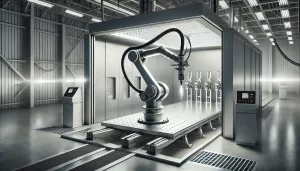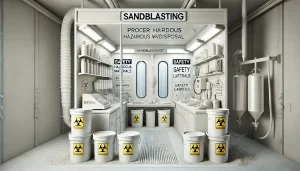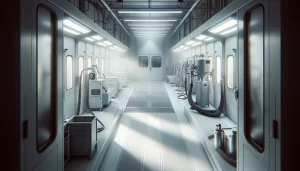What is needed for a paint booth?
Your top priorities when choosing the correct manufacturer to construct your spray booth should be, first and foremost, ensuring that it complies with the minimum standards for paint booths set forth by OSHA, the NFPA, and the EPA. To ensure success when codes and regulations change, you need to assemble the best workforce. What happens once it is constructed? With the help of these general principles and spray booth safety advice, make sure your booth is up to code and is kept in good condition before an inspection.
Key Components of Paint Booth Design
We will look at five main component areas below: paint booth walls and doors, air intake plenum, exhaust chamber, air make-up unit (AMU), and manometer. When it comes to paint booth models, you may choose between single-skin and dual-skin walls.
Paint Booth: Walls and Doors
You can find either single-skin or dual-skin walls in paint booth models. When money is scarce, the former is preferable because it doesn’t sacrifice rigidity and strength. The latter usually has more insulation and is more resilient and long-lasting. For greater reflectivity and visibility in the workstation, you’ll probably find that the walls in both situations are white.
You may believe that a door is simply a door. It only has to open and close, right? Spray booth doors are available in roll-up, swing, and tri-fold configurations. The type of door you require is determined on how you work. If you’re employing non-pressurized booths, for example, filtered doors are almost always required. Although air can travel through them, further filters prevent undesired particles from entering. If the booth is pressurized, solid doors will be used, with air entering through the air intake plenum.
Air Intake Plenum
To maintain a clean environment free of dust and dirt, pressurized booths with solid, sealed doors are supplied with air via the intake plenum. Depending on the specifics of the booth’s construction, the air may come from the floor or the ceiling. Before it enters the space, dust and other impurities are removed by filters within the system.
Exhaust Chamber
The exhaust chamber design keywords are crossdraft, semi-downdraft, side downdraft, and downdraft. The exhaust chamber collaborates with the exhaust plenum and exhaust pit, both of which are components of the overall circulation’s air-removal step. The position of the exhaust components is determined by the keywords listed above.
The plenum, for example, is located in the back of a crossdraft design. The exhaust pit is also included in the downdraft design. Regardless of their exact specifications, they all serve the same basic purpose: to exhaust and filter air from the booth in a way that protects the painter and other key booth components such as fans, stacks, and plenums.
Air Make-up Unit (AMU)
Another crucial component of circulation is Air Makeup. If the air was being pushed out of the system quicker than it could be refilled, the exhaust system mentioned above wouldn’t be much use. The AMU steps in at this point. It will restore equal amounts of exhausted air while maintaining a steady air flow and temperature.
Manometer
The manometer is the final component. This is used to indicate when the paint filters need to be replaced. Overspray and other particles will accumulate on the filter over time, rendering it ineffective. The manometer indicates the current state of the filter, so you’ll always know when to replace it. Manometers range in complexity from simple gauges to photophilic and Magnehelic designs.
Contact Professional Help
In the end, choosing the right kind of paint booth design for your operation will require considerable expertise in support. Paint Booth has you covered when it comes to custom applications and design, We are an industry leader and we are here to find the right solution for you.
How much does it cost to build a paint booth?
Your paint booth is frequently your biggest outlay when it comes to painting (unless you are a large manufacturer with a lot of additional paint equipment). You should plan your building with the cost of your paint booth in mind if you intend to start an auto body shop, an industrial coating facility, a fabrication business, or even a hobby shop.
Related: Powder Coating Booth: Pros & Cons
Amount of air the paint booth exhausts
To meet NFPA 1 and, more specifically, NFPA 33, paint booths must remove a considerable volume of air (which is more specific to paint booths). The amount of air removed by your paint booth is determined by whether it is crossdraft, side downdraft, or downdraft. A crossdraft air demand is roughly 100 FPM x the face area of the paint booth opening, whereas a downdraft and side downdraft booth requires 50 FPM x the paint booth footprint. For two reasons, the higher the CFM of the paint booth, the higher the cost.
One is that a bigger exhaust fan will be needed in the paint booth to move the right amount of air. Two, it is more probable that you will need to replace the air in your paint booth, necessitating the use of an air make-up unit. Third, a bigger paint booth will need more ductwork, which will cost more money. Try to keep the size of your paint booth as close to the smallest face area for a crossdraft or footprint for a downdraft as possible to keep paint booth costs as low as possible. Refer to the helpful advice in this article to get a general notion of how to choose an acceptable paint booth size.
Will you need an air make up unit for the paint booth?
The air being withdrawn from your building is replaced by an air make up device. It keeps you from losing all of your building’s heat during the winter and avoids creating an excessive amount of negative air pressure because your paint booth will be housed in a compact space. This page provides the information you need to decide whether you need to take into account an air make-up unit for your spray booth. Alternatively, you can use the calculator below to assess how quickly you will exhaust all the air from your facility.
Essentially, we are trying to assess if you will be able to remove all of the air from your facility in 20 minutes or less, which will undoubtedly necessitate the consideration of an air make up, and if a cold paint booth in winter will be troublesome for production and long-term demands. In general, air make up for a paint booth is one of the most expensive expenses, frequently costing as much as or more than the paint booth itself.
Is the booth a factory standard or completely custom?
Standard spray booths won’t cost as much and won’t require custom engineering. Standard spray booths have size limitations, so if you have a precise size requirement, a custom-engineered paint booth may be required. Due to the specialized manufacturing and engineering required, a custom-designed paint booth may wind up costing significantly more than a pre-designed paint booth.
How big is the paint booth?
The size of the paint booth will necessitate variable amounts of sheet metal, as well as additional structural support if it is more than a specific size. Furthermore, booths are often priced in the following order: crossdraft, downdraft, side downdraft. You must factor in the expense of concrete work for a downdraft because it has a concrete pit in the floor.
A side downdraft paint booth requires double the fans and double the duct runs of a crossdraft paint booth. Consider the following as a broad pricing range; this is without duct work (the fifth factor) and does not include an air make up.
How much duct-work will your spray booth need?
Two factors will determine ductwork cost. How big a duct will you need, and how long will the duct runs need to be? For the smallest to largest duct lengths, the price of plain exhaust duct, which is typically utilized with a spray booth, will range from $15 to $60 per foot.
If you have long lengths of duct and greater diameter duct, a spiral duct may be required, which is more expensive, ranging from about $36 per foot to $125 per foot for a large diameter duct. If you have several elbows or a very long exhaust distance, you may have to pay an extra fee for an exhaust fan optimized for high static resistance. An access duct that enables for cleaning of the booth’s exhaust fan may potentially be an additional cost (which is highly recommended).
Who is manufacturing your paint booth?
The price of paint booths might vary very slightly. You should also ensure that your paint booth complies with all applicable national codes. You can read a helpful summary of national code compliance here.
While costs will vary between manufacturers, they should typically be within 10% to 15% of one another. If they are not, you should check to see if one company has extra features like startup assistance, a different air make up size, different duct lengths, or different features in your spray booth’s control panel.
The knowledge of your local support firm, which is always beneficial, and a well-known, highly rated manufacturer will be important factors in picking a paint booth. By weighing all of these factors, you can better estimate the cost of a potential paint booth job. You will also have a good sense of what to expect in terms of paint booth pricing.
We believe in earning your business with the Quality, Integrity & Service you deserve!
SEND US YOUR QUOTES WE WILL MEET OR BEAT ANY COMPETITORS SIMILIAR QUOTES!




